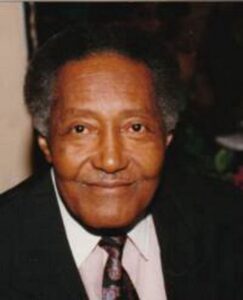
Robert Hicks
*Robert Hicks was born on this date in 1929. He was a Black laborer and activist in Bogalusa, Louisiana.
Robert 'Bob' Hicks was born in Pachuta, Mississippi, the youngest child of Quitman and Maybell Crawford Hicks. He moved to Bogalusa, Louisiana, with his family as a child. In 1947, Hicks graduated from the segregated Central Memorial High School and played offensive guard and defensive end on the State Championship football team. He later played offensive guard for The Bushmen, an all-Black semi-pro team.
After high school, he married Valeria Payton of Bogalusa; they raised seven children. After being denied admission to the Bogalusa Vocational Tech College, she traveled to New Orleans daily to earn her Licensed Practical Nurse degree. Hicks began his work as a shop steward at Bogalusa's paper mill. He became an outspoken union organizer, serving as president of the segregated International Brotherhood of Pulp, Sulphite, and Paper Mill Workers, an organizational foundation.
He was an active member of the Bogalusa chapter of the N.A.A.C.P. and the Bogalusa Civic and Voters League (B.C.V.L.), one of several local voting rights organizations formed in response to the state ban. In 1965, the Congress of Racial Equality (CORE) assigned two civil rights workers, William "Bill" Yates, a former Cornell professor, and Steve Miller, an Antioch College student, to Bogalusa to help organize "testing" and protests to desegregate local public accommodations.
On the evening of February 1, 1965, Robert Hicks and his family had just sat down for dinner with their guests when there was a knock at the door. Bogalusa Chief of Police Claxton Knight and Deputy Sheriff Doyle Holliday had come to inform Hicks that a mob of two hundred white men had gathered, prepared to murder the entire family and burn the house to the ground if he didn't put the white activists out, adding that they should expect no help from law enforcement: "We have better things to do than protect people who aren't wanted here." When Yates asked if they could stay, he replied, "Hell yeah." He recalled, "We just knew that if [they] left our house, we would never see them alive again."
The Hicks family, including the children, began phoning black men all over Bogalusa—friends, fellow mill workers, church brethren—asking them to come to the house as fast as possible with loaded guns. Meanwhile, Yates & Miller called CORE, who alerted the Department of Justice, the F.B.I., and the Louisiana governor's office. Once the calls were made, the children were hidden in a getaway car and driven to a safe house. Within minutes, black men with shotguns arrived. The two law enforcement officers, who had parked outside, drove off. The angry mob never appeared.
That night's episode marked the beginning of the Bogalusa civil rights movement. This movement was unique at the time because it broke from the principles of non-violence and instead asserted the right to armed self-defense against white aggression. In an interview, Hicks explained: "Since we can't get the local officials to protect us in our community, our neighborhood, let's back up on the Constitution of the United States and say that we can bear arms. We have a right to defend ourselves since the legally designated authorities won't do it."
On February 21, 1965, Robert Hicks and fellow activists Bert Wyre, Fletcher Anderson, Charles Sims, and others founded the Bogalusa chapter of the Deacons for Defense and Justice, headquartered in Robert Hicks' home to protect the family on February 1. The Deacons had been founded in 1964 in the mill town of Jonesboro, Louisiana, as an armed self-defense organization of black men to protect local citizens and civil rights workers against the Ku Klux Klan and other white vigilantes. On May 19, 1965, a day that became known as "Bloody Wednesday," Robert Hicks and fellow Deacon Sam Barnes notified local law enforcement and the F.B.I. that they planned to lead a group of black citizens, including children, to the white-only Cassidy Park, the largest public park in Bogalusa.
Soon after they arrived, a white mob approached, accompanied by local police, and began attacking the black adults and children. Hicks' 15-year-old son Gregory was bitten in the leg by a police dog, and a 75-year-old woman was knocked unconscious. Both were refused treatment at the Bogalusa Community Medical Center. Four days later, the Mayor of Bogalusa signed a six-point desegregation agreement with the Bogalusa Civic and Voters League. That episode created the lawsuit Hicks v. Knight.
Robert Hicks, whose activism helped end segregation and discriminatory practices in education, housing, employment, public accommodations, and healthcare during the American Civil Rights Movement, died on April 13, 2010. On August 28, 2010, four months after Robert Hicks' death from cancer, East 9th Street in Bogalusa was officially renamed Robert "B.O.B." Hicks Street.